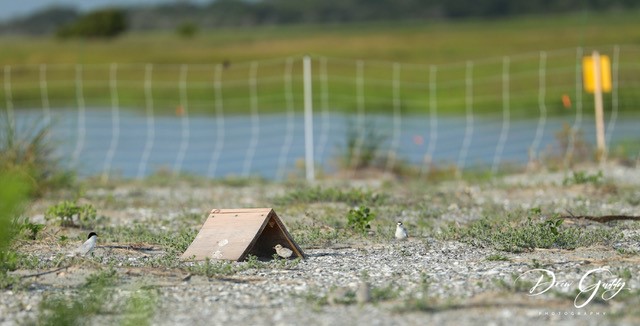August 18, 2020

Chick Tent at Huntington Beach State Park Least Tern colony. Photo by Drew Getty.
Preliminary data collected by SCDNR biologists shows that South Carolina had an average Least Tern nesting season for 2020 with approximately 1,000 nests recorded.
The smallest tern in the Americas, the Least Tern, prefers nesting on sandy beaches, but will use a flat gravel roof of a building or occasionally a pebbled lot or pier. Like a gull, Least Terns feed on fish.
Due to loss of nesting habitat Least Terns are listed as threatened in South Carolina.
Least Terns nest as a group called a colony, and this year 25 colonies were active with nine located on S.C. beaches. Flooding of low-lying beaches, human disturbance during nesting, and predators can prevent Least Terns from successfully nesting. Nesting success was poor this year at most colonies partly because of crows, mink, and coyote that may have eaten eggs and chicks and threatened the tern parents. However, two beach colony sites were successful due to the efforts of dedicated and hardworking SCDNR partners.
Huntington Beach State Park staff and volunteer efforts produced another generation of Least Terns. The nesting area was located on the beach at the north end near Murrells Inlet which is a popular boating and visitor destination.
An electric fence surrounded the colony to protect the eggs and chicks from mammalian predators. State Park Ranger Mike Walker monitored the site daily, and along with volunteers, educated visitors every weekend from May into July about the small white birds nesting on the beach.
If dogs and people get too close, the parent birds will leave their nests, and the eggs and chicks can overheat and die. In the winter, Walker prepared for the Least Terns by having students help put together “chick tents” which provided shade and protection to the Least Tern parents and chicks at the site.
Protection efforts on another beach north of Charleston also resulted in a successful Least Tern colony. Ninety-eight nests were counted on the south end of Lighthouse Island which is a popular weekend recreation spot with up to 200 visitors each day.
Jennifer Cahill, a SCDNR beach steward funded through the SC Coastal Bird Conservation Project, educated boaters every weekend and holidays from May through June, about the magnificent seabirds that were raising their young on the beach. Cahill’s appreciation for the Least Tern colony was contagious and weekend visitors were able to watch from a distance the progression from eggs in May to fully feathered young taking their first flights in June.
SCDNR wants to thank Cahill, Walker, beach visitors, and volunteers for efforts that resulted in two successful Least Tern nesting colonies this summer.



